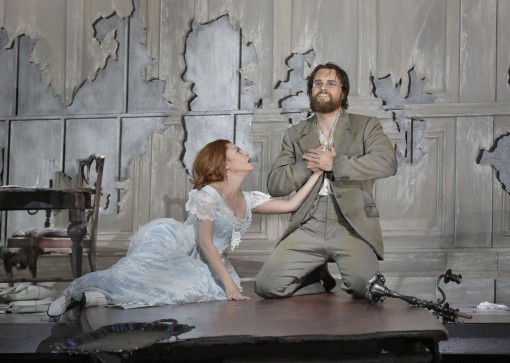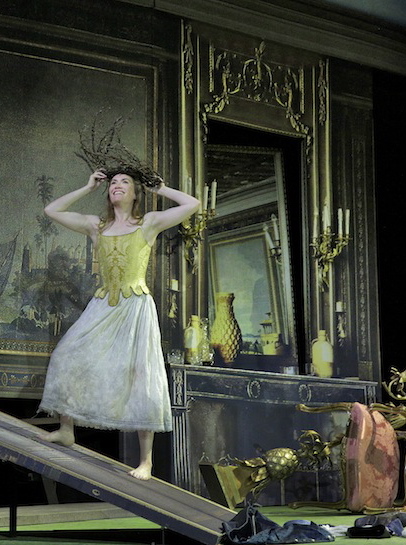Powerful “Salome” and problematic Mozart at Santa Fe Opera

Alex Penda in the title role and Ryan McKinny as Jochanaan in Santa Fe Opera’s production of Strauss’s “Salome.” Photo: Ken Howard
Why do people laugh so much in performances of Richard Strauss’s Salome? If anything the amount of tittering increased in the performance of the company’s new production heard on Thursday night. There are comic moments in the libretto, to be sure, but too many people laugh in the wrong places at parts of the opera that are, or should be, the most disturbing.
English director Daniel Slater’s powerful staging, updated to the turn of the 20th century and based on the sexual identity theories and dream interpretation of Sigmund Freud, eventually silenced most of the laughter. Slater directed a blood-curdling Wozzeck here, last seen in 2011, and many parts of the creative team are reunited, including conductor David Robertson and tenor Robert Brubaker, as a magnificent Herod. The costumes, if not so much the set (both designed by Leslie Travers), show a court that could be Edwardian England or Kaiser Wilhelm II’s Germany, with the men all in military uniforms. Alex Penda’s Salome wears a virginal, ankle-length, lace-covered dress, with prim white gloves and a shawl to cover her shoulders, her long red hair in ringlets.
In his program note about the opera, Slater adds a new wrinkle to the story, claiming that John the Baptist was imprisoned in the same cistern where Salome’s father was held captive, until he was murdered by his brother, the Herod who now holds the throne. Salome’s dance, usually the most awkward part of this opera, becomes instead a dream that is played out behind Salome’s movements (as choreographed by Seán Curran, Penda stripped down to her slip; later she will remove her corset too, but nothing else).
In a series of scenes within scenes, pieces of steely grey blocks revolve to different positions, as we see inside Salome’s mind. Her father, who resembles the character of Jochanaan and is imprisoned in the same cell as the prophet, is murdered by a double of Herod. In the dream, a child version of Salome watches helplessly, only later to be molested and tormented by the man who killed her father. The young girl crawls into the smallest space of this mirror within mirrors, to hide her terror.
With elements that recall Freud’s Case Study of Dora and Jung’s theory of the Electra Complex, this interpretation deepens our understanding of Herod’s scandalous attraction to Salome and her hatred of him, as well as her ineluctable attraction to Jochanaan, even though he does all he can to repel her. It also makes the horrifying conclusion of the opera, where Salome kisses and fondles the prophet’s severed head, doubly disturbing. Salome has become just as incestuous and murderous as her hated uncle.
Brubaker’s neurotic Herod, more beautifully sung than shouted as usual, was matched by the imperious Herodias of mezzo-soprano Michaela Martens, who was just as good in her Santa Fe debut as Marcellina in the 2008 Marriage of Figaro. Ryan McKinny thundered to good effect as Jochanaan, easily heard from within the cistern, and tenor Brian Jagde’s clarion voice made his performance as the sensitive Narraboth, the captain of the guard who kills himself over his unrequited love for Salome, even more poignant. The only weak link was the Salome of soprano Alex Penda, beautifully acted but with not enough power at crucial moments. Hopefully, this was an off night since she was excellent as Leonore in last season’s Fidelio.
Apprentice singers Megan Marino and bass-baritone Nicholas Brownlee, as the Page of Herodias and the First Soldier, distinguished themselves from an overall fine supporting cast. David Robertson, music director of the Saint Louis Symphony Orchestra, led the orchestra with a firm hand, with strong ideas about tempos and highlighting themes, stirring up orgasmic crescendos at all the right moments without ever covering the singers.
___________
Mozart is a fixture at Santa Fe Opera, although the company sticks mostly to Don Giovanni, Magic Flute, Così fan tutte, and Marriage of Figaro in a four-year rotation. Every few years, though, an unusual Mozart work sneaks in, like The Impresario last season.
This summer it was time for the company debut of an early Mozart work, La Finta Giardiniera, the first of the composer’s teenage operas, which have not been represented here since Lucio Silla in 2005.
Mozart composed La Finta Giardiniera when he was 18 years old, on a commission from the Elector of Bavaria for his court theater in Munich, where it was premiered in 1775. In it one can already hear Mozart the operatic master, fully in control of dramatic characterization, especially in the extended ensemble finales. His handling of the orchestra, his writing for voices, and his ability to use music to heighten the tension on stage are all advanced by this point. The only thing holding him back in this opera was the libretto, attributed to Giuseppe Petrosellini, and over which Mozart had no control in either developing or changing the work.
The story follows a marchioness who disguises herself as a servant to search for the man she loves, Count Belfiore, even though he stabbed her (by mistake) and left her for dead. She pretends to be a gardener, thus the title, in the home of the Podestà of Lagonero, who falls in love with her, which peeves his housekeeper, Serpetta, because he once promised to marry her. The marchioness has her servant, Nardo, in tow, who falls in love with Serpetta, and as chance would have it the Podestà has arranged to have his niece, Arminda, married to none other than Count Belfiore, although a knight, Don Ramiro, is in love with her.
All that really matters is that there are characters on three social levels: aristocracy, gentry, and servants. Like any good comedy, each social class has to end up with the same social class, and indeed we end up with three happy marriages at the end. The problem with the opera is that the resolution takes far too long to sew up—even with about an hour of music excised in this production, which still ran over three hours. Mozart dutifully set all of the text, with beautiful music, but it loses its dramatic punch somewhere around the end of the second act.
Soprano Heidi Stober was a pretty and sympathetic Sandrina, the name of the marchioness in disguise, with only some occasional stridency at the top. Susanna Phillips was a hilariously temperamental Arminda, opening up with some force where she needed it vocally and even destroying her necklace in Act II.
Spanish tenor Joel Prieto made a fine company debut as Count Belfiore, a handsome singer with a decent voice, although some stiffness in melismatic passages. Joshua Hopkins was a forthright Nardo, staid mostly because the libretto does not give him much comedy to work with, while mezzo-soprano Cecelia Hall was strong in her company debut in the trouser role of Ramiro.
Tenor William Burden, a long-time house favorite, brought fine comic timing to the Podestà’s showpiece aria “Dentro il mio petto,” where Mozart gradually adds flute, bassoons, trumpets, and timpani to his previously small orchestra, in reaction to the character’s worried hallucinations. Soprano Laura Tatulescu, although somewhat underpowered, was a venomous Serpetta, with a whole vocabulary of sneers and dirty looks at her command. Harry Bicket, the company’s music director, conducted the score with crisp tempos, not giving way to singers who rushed ahead. The orchestra sounded in excellent form, especially the beautifully balanced and active woodwinds, who have a lot more to do in the Náměšt re-orchestration of the work used here, made in 1796 by someone other than Mozart.
Tim Albery, who directed a puzzling Magic Flute for Santa Fe Opera, last seen in 2010, created a stronger staging here, keeping the set (designed by Hildegard Bechtler) and the costumes (Jon Morrell) in the 18th century. A simple set was in place for the first half of the opera, showing the curved wall of a manor house to one side of a garden. When the story took a crazy turn, involving the marchioness being stranded in a nearby forest, the stage transformed into a rough terrain filled with menacing branches and overturned furniture. The symbolism of the staging, echoing the madness all of the characters descend into, made a pleasing effect, helped by the arrival of a desert rainstorm.
Salome continues through August 27 and La Finta Giardiniera runs through August 21 at Santa Fe Opera. santafeopera.org.
Charles T. Downey is a freelance writer on music and roving summer festival reporter. The rest of the year he lives in Washington, D.C., where he writes reviews for the Washington Post and moderates ionarts.org, a Web site on classical music and the arts.

Posted Aug 08, 2015 at 6:59 pm by Tom Arthur
Charles, I too was puzzled by the untimely laughter when I went on the opening night of Salome in Santa Fe and am sorry to know that it continued when you were there. I have no explanation or even a theory about the possible reason for it but wish someone who heard more than one performance would try to analyze what might have been going on in the minds of those who snickered or laughed out loud. Very odd indeed.
Posted Aug 17, 2015 at 10:16 pm by Charles
Thanks, Tom — the laughter was even more pronounced this year than it was the last time I saw ‘Salome’ in Santa Fe, in 2006. Weird.
Posted Aug 19, 2015 at 12:15 pm by John Ed Niles
The laughter, while a bit surprising did not really bother me. It happens sometimes in situations like this. I remember Frank Rizzo warning Ardis Kranik when he was doing the titles for the Third Act of LULU at Chicago Lyric that there might be laughter in some places and to be ready for it. T.M. I. sometimes can rear it ugly head. There was laughter in Seattle Opera’s Das Rheingold.
Posted Aug 19, 2015 at 5:28 pm by lin in Boulder
I think people laugh at the translation. The only example I can remember now is in Tosca when the supertitles translated “make the portrait have drark eyes,” into “give her a black eye.”
Supertitle writers should look at where folks laughed at their translations and work on that.